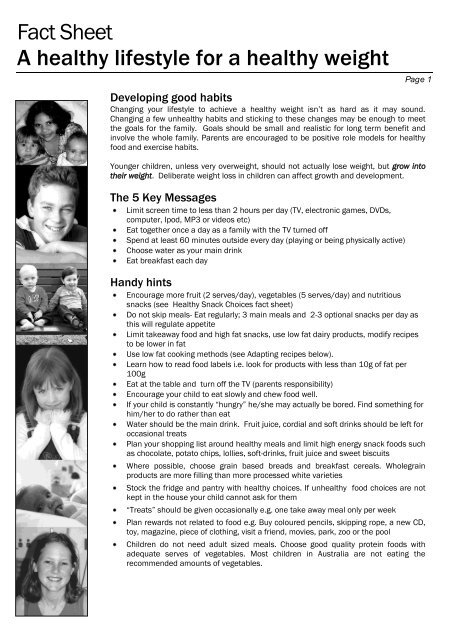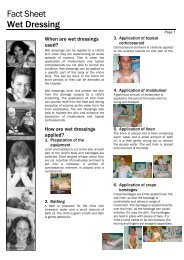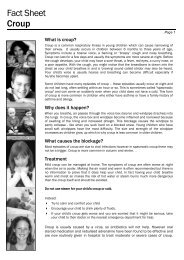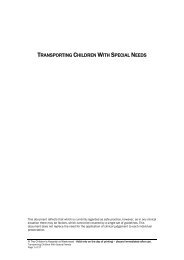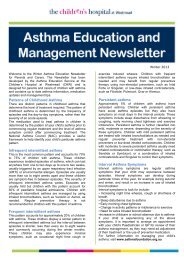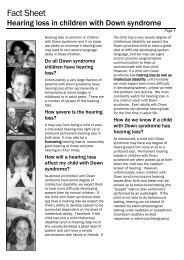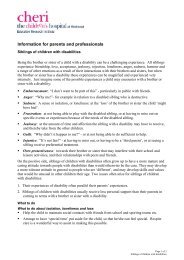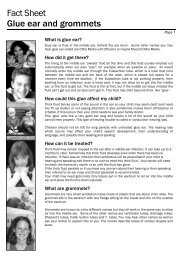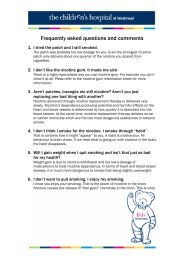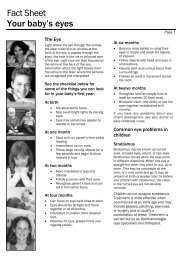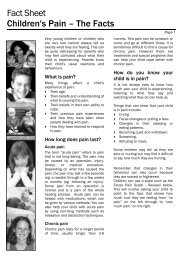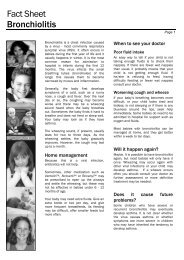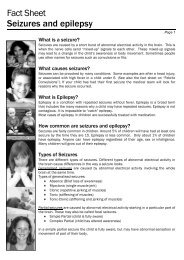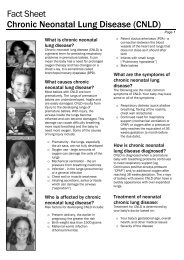Fact Sheet - Kids Health @ CHW
Fact Sheet - Kids Health @ CHW
Fact Sheet - Kids Health @ CHW
You also want an ePaper? Increase the reach of your titles
YUMPU automatically turns print PDFs into web optimized ePapers that Google loves.
<strong>Fact</strong> <strong>Sheet</strong><br />
A healthy lifestyle for a healthy weight Page 1<br />
xcvxcvxcv<br />
Developing good habits<br />
Changing your lifestyle to achieve a healthy weight isn‟t as hard as it may sound.<br />
Changing a few unhealthy habits and sticking to these changes may be enough to meet<br />
the goals for the family. Goals should be small and realistic for long term benefit and<br />
involve the whole family. Parents are encouraged to be positive role models for healthy<br />
food and exercise habits.<br />
Younger children, unless very overweight, should not actually lose weight, but grow into<br />
their weight. Deliberate weight loss in children can affect growth and development.<br />
The 5 Key Messages<br />
Limit screen time to less than 2 hours per day (TV, electronic games, DVDs,<br />
computer, Ipod, MP3 or videos etc)<br />
Eat together once a day as a family with the TV turned off<br />
Spend at least 60 minutes outside every day (playing or being physically active)<br />
Choose water as your main drink<br />
Eat breakfast each day<br />
Handy hints<br />
Encourage more fruit (2 serves/day), vegetables (5 serves/day) and nutritious<br />
snacks (see <strong>Health</strong>y Snack Choices fact sheet)<br />
Do not skip meals- Eat regularly; 3 main meals and 2-3 optional snacks per day as<br />
this will regulate appetite<br />
Limit takeaway food and high fat snacks, use low fat dairy products, modify recipes<br />
to be lower in fat<br />
Use low fat cooking methods (see Adapting recipes below).<br />
Learn how to read food labels i.e. look for products with less than 10g of fat per<br />
100g<br />
Eat at the table and turn off the TV (parents responsibility)<br />
Encourage your child to eat slowly and chew food well.<br />
If your child is constantly “hungry” he/she may actually be bored. Find something for<br />
him/her to do rather than eat<br />
Water should be the main drink. Fruit juice, cordial and soft drinks should be left for<br />
occasional treats<br />
Plan your shopping list around healthy meals and limit high energy snack foods such<br />
as chocolate, potato chips, lollies, soft-drinks, fruit juice and sweet biscuits<br />
Where possible, choose grain based breads and breakfast cereals. Wholegrain<br />
products are more filling than more processed white varieties<br />
Stock the fridge and pantry with healthy choices. If unhealthy food choices are not<br />
kept in the house your child cannot ask for them<br />
“Treats” should be given occasionally e.g. one take away meal only per week<br />
Plan rewards not related to food e.g. Buy coloured pencils, skipping rope, a new CD,<br />
toy, magazine, piece of clothing, visit a friend, movies, park, zoo or the pool<br />
Children do not need adult sized meals. Choose good quality protein foods with<br />
adequate serves of vegetables. Most children in Australia are not eating the<br />
recommended amounts of vegetables.
<strong>Fact</strong> <strong>Sheet</strong><br />
A healthy lifestyle for a healthy weight Page 2<br />
xcvxcvxcv<br />
Adapting recipes<br />
Favourite recipes can be high in fat, sugar and salt, and low in fibre, so they don't fit in<br />
with the dietary guidelines for good health. But this doesn‟t this mean you need to throw<br />
out old cookbooks and buy new ones. Many recipes can be adapted to fit in with healthy<br />
eating practices, without spoiling the flavour or appearance of the dish.<br />
Here are some hints to help<br />
Use low fat cooking methods ie BBQ, dry fry (in non-stick pan), steam, bake on a rack<br />
or grill<br />
Lean meat can be cooked on a low heat, using a non-stick pan, or you can brush or<br />
spray the pan lightly with oil before cooking.<br />
Choose lean cuts and trim off any visible fat and skin for all meat dishes and monitor<br />
portion sizes<br />
Consider reducing the meat serving by replacing with vegetables/legumes or salad<br />
Don‟t cook with a lot of added fat- mono and poly unsaturated oils are best in small<br />
amounts i.e. 1-2 teaspoons for a recipe serving of four. If you can leave it out<br />
altogether, even better!<br />
Cook onions and garlic in a small amount of water, wine, stock or vegetable juice<br />
instead of browning in margarine or oil as many recipes suggest<br />
Cream and sour cream are sometimes used to make sauces. These can be replaced<br />
by lower fat varieties or a light and creamy evaporated milk or a low/non-fat plain<br />
yogurt- but make sure you add this at the last minute, and don't re-boil the sauce or<br />
it will curdle. For white sauces, use low-fat or skim milk in place of full-cream milk,<br />
and the minimum amount of butter or margarine<br />
Use evaporated skim milk with a teaspoon of coconut essence or coconut<br />
evaporated milk (Carnation brand) as a replacement for coconut milk in curries etc<br />
Serve low-fat custard, yogurt, fruche or ice cream instead of cream as an<br />
accompaniment with fruit<br />
Whip equal quantities of ricotta cheese and low-fat plain yogurt with a small amount<br />
of sugar or honey for a cream substitute<br />
Finally - Key Dietary messages:<br />
Eat breakfast<br />
Good breakfast choices include wholegrain, high fibre cereals such as Special k or multi<br />
grain bread for energy and lean protein for fullness.<br />
Choose water as the main drink<br />
Soft drinks, cordials and fruit juices are high in energy and sugar, without providing many<br />
other nutrients. For this reason water should be the main drink of choice for children.<br />
Watch the snacks<br />
Limit high energy snacks and choose only one small packaged snack food for the school<br />
lunchboxes each day and a calcium rich dairy choice.
<strong>Fact</strong> <strong>Sheet</strong><br />
A healthy lifestyle for a healthy weight Page 3<br />
xcvxcvxcv<br />
Choose low GI carbohydrates<br />
Choose breads, cereals, rice and pastas which are low GI carbohydrate rich foods.<br />
Have set meals and mid meals<br />
Meals need to be consumed away from distraction such as television and ideally<br />
consumed with the family at the table.<br />
Add in the treats<br />
Food and eating times for children needs to be enjoyable and fun. It is important to<br />
include regular, portion controlled treats once or twice per week as this achieves a<br />
balance between good nutrition and overeating when these foods are available. School<br />
canteen or takeaway meals once each week, are two examples of treats that can be<br />
included on a weight control plan for children and adolescents<br />
Eat plenty of vegetables and salad<br />
Encourage your children to eat salad and vegetables for lunch and dinner. This will give a<br />
range of nutrients needed for good health.<br />
Physical activity<br />
Physical activity is a very important part of a healthy lifestyle for the whole family.<br />
Exercise not only helps to maintain a healthy weight, but it can be fun and make your<br />
child feel good! Exercise helps our children‟s bodies in many ways including:<br />
Helping growth and muscle development<br />
Keeping your child‟s bones, heart and lungs strong and healthy<br />
Taking your child‟s mind off eating whilst being fun at the same time<br />
Australia‟s physical activity guidelines encourage:<br />
That children should participate in at least one hour of physical activity per day<br />
Children spend no more than two hours using electronic media (eg. tv, computer,<br />
video games)<br />
Children need at least an hour of physical activity per day, and more if trying to<br />
control weight<br />
Physical activity can be lifestyle / incidental exercise or „organised‟ exercise. Both forms<br />
of exercise promote a healthy weight; however, „lifestyle‟ exercise is usually easier to<br />
stick to longer term.<br />
Examples include:<br />
Lifestyle exercise Organised exercise<br />
Playing Weekend sports (netball, soccer, tennis)<br />
Walking to and from school Training<br />
Taking the stairs Dancing<br />
Gardening Swimming squad<br />
Walking the dog Holiday programmes and sport camps<br />
through the Department of Sport and<br />
Recreation
<strong>Fact</strong> <strong>Sheet</strong><br />
A healthy lifestyle for a healthy weight Page 4<br />
xcvxcvxcv<br />
Spend some time doing enjoyable activities with your children. This could include:<br />
Skipping<br />
Throwing or kicking a ball<br />
Roller blading<br />
Dancing<br />
Brisk walking<br />
Cycling<br />
Swimming – under adult supervision if the child is not confident in water<br />
Using a pedometer and building up the steps<br />
Enjoying activities as a family on the weekend<br />
You don't need to join a gym or buy expensive equipment to have fun and make exercise<br />
a part of your day!<br />
How much and how often<br />
Start by identifying a time that fits into your day to day routine ie before / after school or<br />
after dinner. By finding a convenient time it is harder to find excuses.<br />
Slowly build up more vigorous exercises i.e. start with 10 minutes and gradually build up<br />
to 30 minutes most days.<br />
Be realistic with your physical activity goals!<br />
Remember<br />
Eat regular healthy meals, especially breakfast<br />
Be active<br />
Drink lots of water<br />
Eat together as a family<br />
Limit TV viewing, DVDS, computers to less than two hours per day<br />
If you think your child may have a weight problem then you should arrange for<br />
your child to be reviewed by your general practitioner (GP). This will include<br />
assessment of your child‟s height and weight<br />
This fact sheet is for education purposes only.<br />
Please consult with your doctor or other health professional<br />
to make sure this information is right for your child. This document was reviewed on 19 th<br />
April 2011<br />
www.chw.edu.au www.sch.edu.au www.kaleidoscope.org.au<br />
© The Children’s Hospital at Westmead, Sydney Children’s Hospital, Randwick & Kaleidoscope * Hunter Children’s <strong>Health</strong> Network 2011


